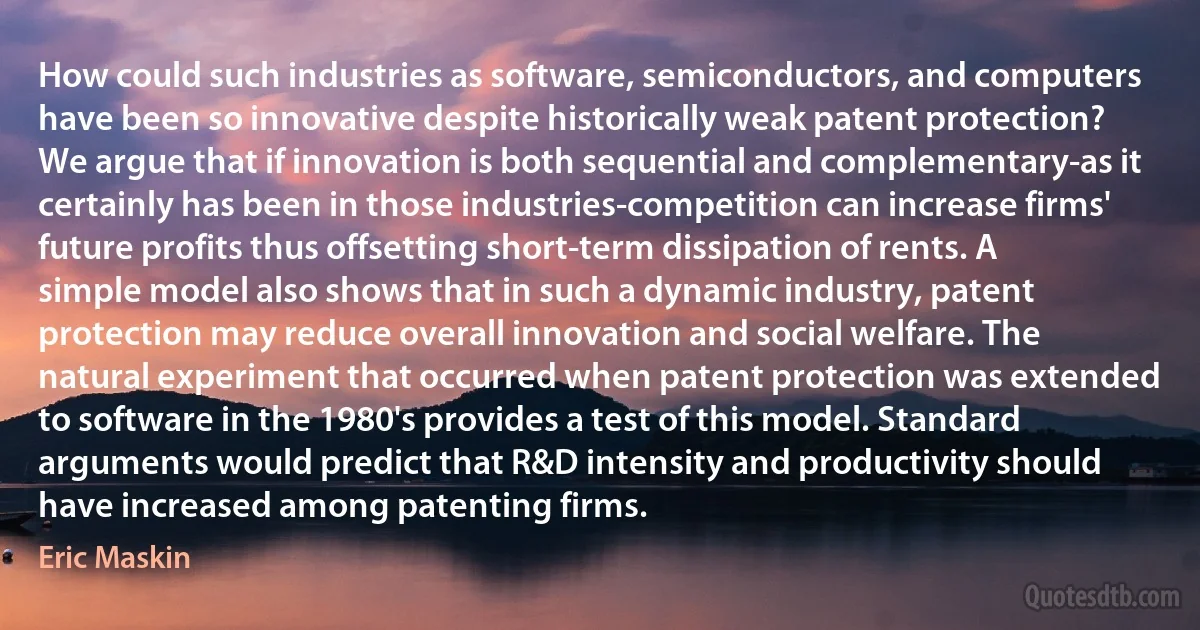
How could such industries as software, semiconductors, and computers have been so innovative despite historically weak patent protection? We argue that if innovation is both sequential and complementary-as it certainly has been in those industries-competition can increase firms' future profits thus offsetting short-term dissipation of rents. A simple model also shows that in such a dynamic industry, patent protection may reduce overall innovation and social welfare. The natural experiment that occurred when patent protection was extended to software in the 1980's provides a test of this model. Standard arguments would predict that R&D intensity and productivity should have increased among patenting firms.
Eric MaskinRelated topics
dissipation dynamic experiment future increase industry innovation intensity model natural overall patent predict productivity should simple thus profits software rentsRelated quotes
In recent years there has been increased interest in the effects of internal communication on decision processes. A number of hypotheses relating the bias in information to the final decision have been proposed. In this paper we discuss two laboratory experiments which were designed to test two such hypotheses. The first experiment tests the hypothesis that cost and sales estimations are made with the implicit assumption that a biased pay-off structure exists. The second experiment tests explicitly the effects of biased and unbiased pay-off structures on estimation within an organization. An analysis of the data for the two experiments is made and some implications for further research are drawn from the results.

James G. March
The phase transition paradigm: The standard model of fundamental physics incorporates, as one of its foundational principles, the idea that "empty space” or "vacuum” can exist in different phases, typically associated with different amounts of symmetry. Moreover, the laws of the standard model itself suggest that phase transitions will occur, as functions of temperature. Extensions of the standard model to build in higher symmetry (gauge unification or especially supersymmetry) can support effective vacua with radically different properties, separated by great distance or by domain walls. That would be a form of failure of universality, in our sense, whose existence is suggested by the standard model.

Frank Wilczek
It seems beyond doubt that the tariff policy pursued during the last half century has not raised the standard of living of the labouring classes. It is doubtful if agricultural duties increase the relative scarcity of manual labour compared with other factors, and they certainly raise the cost of living for the working classes. It is, however, true that manufacturing duties tend to depress the rent of farm land... It is on the whole not at all unlikely that the sum total of rent is reduced in countries with high manufacturing duties... In most countries, however, the sum of rents is small compared with the sum of wages to manual workers. Even a substantial reduction of the former brings only a slight increase in the latter.

Bertil Ohlin
Had Mr. Darwin written a work on the change of species, as determined by observation and experiment, without any other object but that of advancing natural science, he would have obtained a high place among philosophical naturalists. But after reading his work in which the name of the Creator is never distinctly mentioned, we can hardly believe that scientific truth was the only object the author had in view. Researches, conducted under the influence of other motives, are not likely to stand the test of a rigorous scrutiny; and some of Mr. Darwin's not unfriendly critics have produced ample evidence that the idol of speculation has been occasionally worshipped at the expense of truth.

David Brewster
Even when altruism is allowed (as, for example, in Gary Becker's model of rational allocation), it is assumed that the altruistic actions are undertaken because they promote each person's own interests; there are personal gains to the altruist's own welfare, thanks to sympathy for others. No role is given to any sense of commitment about behaving well or to pursuing some selfless objective. All this leaves out, on the one hand, the evil passions that early theorists of capitalism contrasted with self-interest and, on the other, the social commitments that Kant analyzed in The Critique of Practical Reason and that Adam Smith discussed in The Theory of Moral Sentiments.

Amartya Sen
